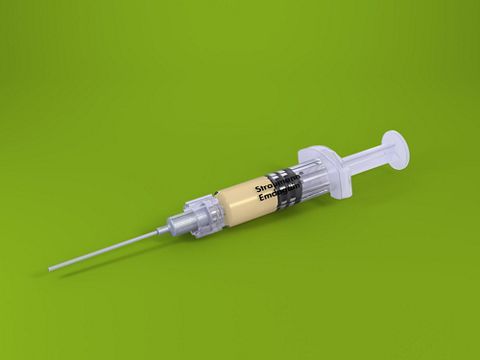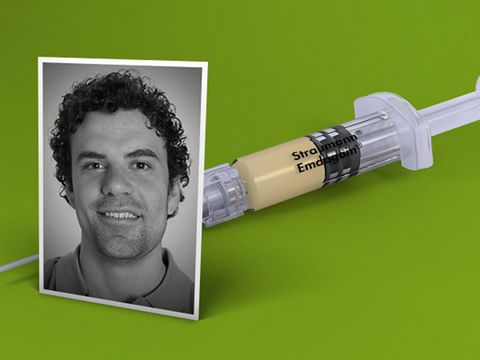Emdogain® in two different clinical scenarios in the same patient
A clinical case report by George Furtado Guimarães, Brazil
"My personal research on using emdogain® for the wound healing as part of dental implantation procedures demonstrated that the product stimulates blood vessel formation and therefore enhances wound healing. Using emdogain® in my daily implant and graft cases may optimize my wound healing results and consequently my patient’s satisfaction." Prof. Dr. Guimarães
Initial situation
A 49-year-old man was referred to our service for evaluation and treatment of gingival recession with root exposure (FDA, tooth 13) and a tooth with a hopeless prognosis because of root resorption (tooth 11) (Fig. 1). After comprehensive examination, no significant health problems and no contraindications for periodontal and implant surgery were detected. For tooth 13, clinical measurements and observations resulted in a diagnosis of a Miller class I recession. For tooth 11, CBCT images (Figs. 2-3) revealed a bucco-lingual bony defect secondary to previous endodontic surgery in very close proximity to the nasopalatine canal. Although they were not the patient’s main complaint, some esthetic issues were observed in the adjacent teeth.
Treatment planning
For the Miller class I recession of the canine, a substantial amount of good quality keratinized tissue was observed at the gingival margin. Consequently, a coronally advanced flap approach was planned, combined with the use of Emdogain®. Regarding the central incisor, a minimally invasive extraction with immediate implant placement and immediate temporization were planned. The bony defect would be addressed using a block bone graft from the posterior mandible. Additionally, nasopalatine content removal was also considered in order to prevent future contact between the implant and that anatomic landmark. Topical application of Emdogain® was envisaged for both situations with the aim of optimizing wound healing.
Surgical procedure
Tooth 11: After local anesthesia, an intrasulcular incision was made all around the tooth with a 15C surgical blade (Fig. 4). A periotome was used to sever both the supracrestal fibers and the interproximal periodontal ligament fibers (Fig. 5). A forceps was carefully applied with slow rotational movements to luxate and extract the tooth (Fig.6). Every effort was made not to jeopardize the remaining buccal plate. Lucas curettes were used to remove all granulation tissue (Fig. 7). The communication between the alveolar socket and the nasopalatine canal (Fig. 8) was confirmed, and all the soft tissue contents in the canal were enucleated using round carbide burs (Fig. 9). The implant was placed against the palatal wall so as to achieve sufficient torque for immediate temporization (Fig. 10). Subsequently, the bone donor site was accessed. A full-thickness incision was made 3 mm below the mucogingival junction from the ascending ramus of the mandible to the distal aspect of the first molar. A flap was raised, and bone blocks measuring 8 mm and 6 mm in diameter were removed using trephine burs (Fig. 11). Sutures were placed. At the implant site, a 6-mm diameter bone block was used to completely fill the nasopalatine canal. Two further blocks were used to repair the buccal and lingual bony defects. The blocks were positioned in a press-fit manner until they were completely stable (Fig. 12). The residual gap was filled with autogenous bone particles. Interrupted sutures were placed in the interdental papillae only. An abutment was selected for a cemented provisional crown, and temporization was performed based on an ideal crown prototype (Figs. 13-14).
Tooth 13: After local anesthesia, an intrasulcular incision was made from the base of the recession to the point where it meets the vertical incisions. Two oblique, bevel incisions were made with a 15C surgical blade mesially and distally to the intrasulcular incision and extended beyond the mucogingival line, creating a trapezoid flap. An initial partial-thickness flap of the interproximal papilla was made using a Beaver® mini blade (Fig. 15), and a full-thickness flap was then raised apical to the recession up to the mucogingival line. Subsequently, a partial-thickness dissection was made apical to this line to promote a tension-free coronal displacement of the flap (Fig. 16). The interproximal papillae were de-epithelialized with microsurgical scissors (Fig. 17). Following soft tissue management, tooth decontamination was performed with Gracey curettes and special burs. A 24% EDTA gel (Prefgel®) was applied to the root surface for 2 minutes and then completely rinsed off with sterile saline. Emdogain® was then applied to the entire root surface (Fig. 18). The flap was positioned coronally above the cementoenamel junction, and a 5.0 nylon suture was carefully placed (Fig. 19). Upon completion of the surgical procedures, Emdogain® was topically applied to the soft tissue manipulated during surgery (teeth 13 and 11) with the aim of enhancing soft tissue healing (Fig.20). The patient was instructed not to rinse or brush his teeth on the day of the surgery to prevent early loss of the Emdogain® gel. Sutures were removed 14 days postoperatively, at which time the healing process was assessed (Fig.21), and new hygiene instructions were issued. The prosthetic phase was also scheduled at this stage.
Prosthetic procedure
After a healing period of 3 months, the prosthetic procedure was performed. In accordance with the patient’s wishes and esthetic needs, teeth 21 and 12 were also prepared (Fig. 22), and individual temporary crowns were made. A tooth-whitening procedure was also carried out (Procedure, products) in both upper and lower arches to optimize the final esthetic outcome. At the time of impression-taking, the abutment torque was confirmed and a customized impression coping was used to copy the resulting profile obtained with the temporary crown. Individual zirconia-ceramic crowns were made and permanently fitted (Figs. 23-24).
Final result
During the first two weeks postoperatively, the patient was followed up every other day to ensure that adequate healing was taking place. Aspects related to inflammation, infection, re-epithelialization of the surgical incisions and soft tissue maturation were assessed. Satisfactory postoperative wound healing was achieved without complications. The combination of a coronally advanced flap and Emdogain® proved to be a good treatment option for this Miller class I case, which resulted in a positive outcome. Immediate implant placement with immediate temporization promoted a satisfactory initial result for the patient. Topical Emdogain® application aided in wound healing, based on the angiogenic properties previously reported by the authors themselves (Guimarães et al. 2015). Although a considerable number of surgical sites were involved at the same time, the patient was highly satisfied and reported no postoperative pain. Regarding the restorative aspects of this case, which was the patient’s main concern, a highly satisfactory esthetic result was obtained. The tooth-whitening procedure and the zirconia-ceramic crowns were key to achieving such goals, in terms of both esthetics and function.
Conclusion
Gingival recession cases are often challenging, especially in the context of immediate implant placement. Careful treatment planning is therefore crucial to a positive long-term outcome. Treatment combining a coronally advanced flap and Emdogain® in the case presented here permitted complete root coverage and satisfactory esthetics. Both the grafted alveolar bony defects and the nasopalatine canal content enucleation were regarded as predictable and important for long-term implant performance. Immediate implant placement and temporization to replace the central incisor provided the patient with good immediate esthetics and contributed to the preservation of the soft tissue architecture during the healing phase which, in turn, was paramount in the final restoration.
This case was realized with the support of Dr. James Carlos Nery, PhD, and Silvio Arouca, MSc.



